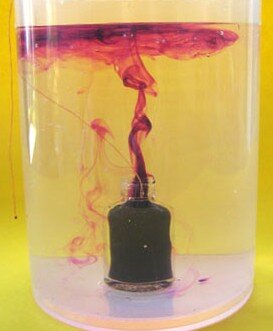Science experiments for children – Convective motions. The phenomenon of thermal convection occurs when a fluid (such as water or air) enter into contact with a body whose temperature is greater than its.
Increasing the temperature by conduction, the fluid in contact with the object expands and decreases in density, and due to the thrust of Archimedes it rises, being less dense than the fluid that surrounds it, which is colder. They thus generate convective motions, in which the hot fluid rises upwards and the cold falls downwards.
Convection is the principal mechanism of heat transfer in fluids and, saying this in a simpler way, is the shift of matter from the areas of higher temperature to the lower temperature and vice versa. Due to the thrust of Archimedes, the hot fluid (lighter than cold), tends to float on the latter and generate convection currents thanks to which cold parts of the fluid are replaced by hot parts and vice versa.
Convection is a very common process in everyday and, in particular, plays a fundamental role in some atmospheric phenomena, such as wind. Furthermore the phenomenon of convection finds application in the construction of heating systems with radiators, in which the circulation of the water inside the tubes and the transmission of heat to the environment is regulated by convective motions.
Science experiments for children – Convective motions
This experiment shows the convection currents in water
and it is carried out very easily by immersing a small transparent jar containing hot dyed water inside a container much larger, also transparent, and containing cold water not colored:

Science experiments for children – Convective motions
Convection Snakes
This game shows convective motions through the movement of a snake of paper, and it is very interesting to propose also to younger children:
Cut a snake (or a colored spiral), tie it on a thread, and place it on a heat source (a candle or a kitchen stove) at a distance that allows its heating, but without catching fire ;-). The snake (or colored spiral) will begin to rotate on itself.
http://www.science-sparks.com/______________________________________
Science experiments for children – Convective motions
Other links
https://en.wikipedia.org/wiki/Convection
http://www.education.com/science-fair/article/convection-air-motion/
http://www.education.com/science-fair/article/convection-movement-heat-fluids/